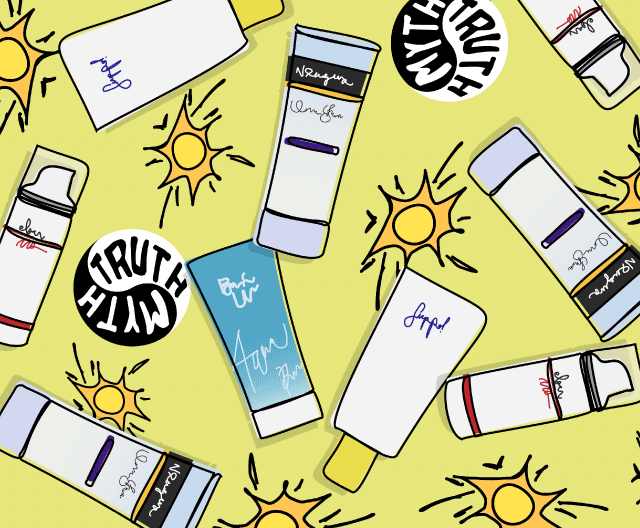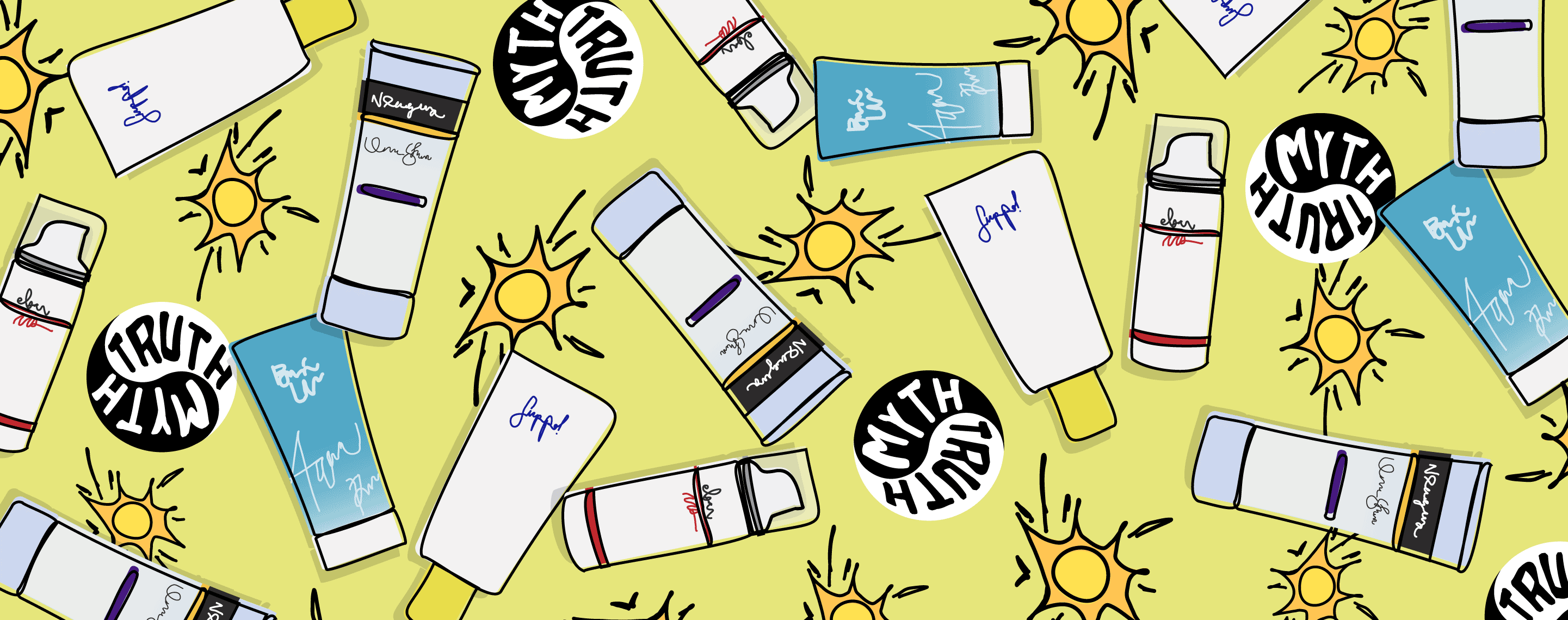Deep Dives
Sun Exposure & Tretinoin or Retinol: What to Know


SHARE
Deep Dives
Sun Exposure & Tretinoin or Retinol: What to Know
Medically reviewed by Aimee Paik, MD
Written by Apostrophe Team
Last updated 4/5/2024
Spend just a few minutes in the sun during the first weeks of using retinoids and you’ll quickly notice one thing: tretinoin can make your skin more sensitive to sunlight than normal.
Retinol is one type of retinoid that’s available over-the-counter in a slew of skincare products, from gels and creams, to lotions and other topical solutions.
Tretinoin is another, more highly concentrated retinoid that works by speeding up your body’s skin cell turnover process, meaning that old skin cells are replaced with new ones at a faster rate than before. This helps to reduce acne and prevent wrinkles, but it also means that your skin can feel more sensitive than usual.
Both are clinically proven to help fight acne and the signs of aging, but one is a little “beefier” than the other.
Retinoids, on the whole, can make your skin more sensitive to light — especially in the first few weeks of use.
This means you might burn faster in the sun (as well as in other exposed conditions, such as windy weather) while you’re using retinol or tretinoin.
Luckily, there are several techniques you can use to protect your skin, reduce your risk of sun damage and get the most from tretinoin if you live in a sunny environment. We’ve listed these tactics below, along with several simple tips to help you stay protected from the sun.
Avoid Long Periods of Sun Exposure
Not surprisingly, the best way to avoid sun damage while using retinoids is to avoid long periods of direct exposure to sunlight.
On a bright, sunny day, your skin can become sunburned in less than 15 minutes of direct sun exposure. This means that even a quick morning walk can be enough to leave your skin with a small amount of sun damage — damage that can be more intense while using tretinoin and retinol.
While you’re using tretinoin or retinol it’s best to avoid spending prolonged amounts of time in direct sunlight.
If you’re planning on spending a lot of time outside, another good tactic is to check the UV index before you leave the house.
The UV index is a metric that measures the strength of the ultraviolet radiation from the sun. On days with a low or moderate UV index (zero to two, or three to five), you can safely spend more time in the sun without having to worry too much about damaging your skin.
On days with a high or very high UV index (six to seven, or eight to 10), it’s best to minimize your level of sun exposure during the daytime, either by protecting your skin using clothing or scheduling the time you spend outside for the early morning or late afternoon, when UV radiation is less intense.
You can check the UV index online using tools like Weather.com, which has live UV index data for most cities. If it’s high, wear a hat, sunglasses and sunscreen to limit your risk of sun damage.
Use an SPF 30+, Broad Spectrum Sunscreen
While avoiding sun exposure is the best way to protect your skin, doing so isn’t always possible or practical. If you can’t avoid spending time in the sun, it’s important to protect your skin using an effective, suitable form of sunscreen.
There are two factors to keep in mind when choosing a sunscreen. The first is the SPF number. This refers to the sunscreen’s ability to protect your skin against ultraviolet B radiation (UVB) — the type of UV radiation that causes sunburn and can lead to the development of skin cancer.
The higher a sunscreen’s SPF number, the greater the level of protection it provides against UVB radiation.
In general, the best approach is to choose the highest SPF sunscreen available. At minimum, a sunscreen with an SPF rating of 15 is a must. However, the higher the SPF rating, the better — especially if you have fair skin. However, the higher the SPF rating, the better — especially if you have fair skin. Most dermatologists recommend an SPF of 30 or more on a daily basis. For sun-intense activities like a day at the beach or mountains, higher SPFs will be more protective.
The second feature to look for in a sunscreen is the term “broad spectrum.” This refers to the sunscreen’s ability to protect you from ultraviolet A (UVA) radiation, which is the form of sun damage that can lead to premature skin aging.
Excessive levels of exposure to UVA radiation are linked to symptoms of skin aging. For optimal results, it’s best to pick a sunscreen that has both a high SPF number and protection against both UVA and UVB rays.
Sunscreen is most effective when applied at least 15 minutes before you go out into the sunlight. If you’re out in the sun frequently throughout the day, aim to apply sunscreen to any retinoid-treated skin every two hours to maintain an optimal level of protection.
And be sure to reapply frequently — every two hours, at least, and immediately following swimming, sweating or toweling off.
Finally, it’s important to remember that while sunscreen helps to keep your skin protected, it’s not perfect. Even with a strong, broad spectrum SPF 30+ sunscreen, it’s still important to limit the amount of time you spend in the sun to avoid sunburn and other forms of skin damage.
Spend Time Inside After Periods of Sun Exposure
Avoiding sunlight isn’t always easy. If you notice that your skin is slightly sunburned after a day out and about, it’s important to take it easy over the next few days to let it recover and prevent further damage.
On average, it takes your body a few to recover from sunburn.
Because skin products like tretinoin and retinol can cause dryness, it’s quite common for your skin to dry out and start to peel during the last few days of the sun burn healing process.
If your skin is sunburned, even slightly, it’s important to avoid further sun exposure. Spending time in the sun risks increasing the level of damage to your skin and slows down the healing process.
Use Moisturizer With Retinoids to Avoid Dryness
With sun exposure comes dryness, flaking and peeling — three side effects of sunburn that are more common with retinoid use.
If you notice that your skin is overly dry after spending even a small amount of time in the sun, adding a moisturizer to your skincare routine could be a good choice. Moisturizers are safe to use with tretinoin and retinol, and can be extremely helpful for treating skin dryness and peeling.
In fact, retinol often comes packaged in moisturizers, to ensure they never cause too many additional skin problems.
Tretinoin is a little different. Moisturizer can be particularly helpful during the “tretinoin purge” period that can occur when you first start using tretinoin, in which it’s common to deal with a higher-than-normal level of dryness.
Using moisturizer with retinoids is simple. Our guide to using tretinoin and moisturizer together covers the entire process, along with simple tips and tactics to help you choose a moisturizer that suits your skin.
Avoid Applying Tretinoin Directly Before Sun Exposure
Because tretinoin comes in higher concentrations than retinol, how and when you apply them can be different.
Retinol is often packaged with moisturizers and broad spectrum sunscreens, so you don’t have to be as selective as when you apply them.
Tretinoin, on the other hand, doesn’t just make your skin more sensitive to sunlight, but it also tends to degrade rapidly when exposed to it.
In a 2013 study, researchers found that tretinoin 0.05 percent micronized gel degraded by 11 percent after eight hours of exposure to fluorescent light.
Conventional gel, which is widely used as a topical treatment, degraded even more, losing 83 percent of its active ingredient within two hours.
In simple terms, while retinol can be applied with less caution, direct sun exposure may reduce the effectiveness of tretinoin, meaning you’ll get less significant results from tretinoin if you apply it to your skin shortly before you go out in direct sunlight.
Because of this, the best time to apply tretinoin is in the evening, letting the medication work overnight without any risk of interruption due to UV radiation. Our guides to using tretinoin for acne and for anti-aging explain this entire process in more detail.
Learn More About Tretinoin, Retinol and Sun Damage
Do you live in a sunny part of the world? While retinoids can make your skin more sensitive to sunlight, they’re also highly effective at reversing many of the signs of aging caused by excessive levels of sun exposure.
From wrinkles to skin discoloration, roughness and more, our guide to treitnoin’s effects on sun-damaged skin goes into more detail about how you can use tretinoin to treat damage caused by long-term exposure to sunlight.
You can also learn more about tretinoin as an acne and anti-aging treatment in our Tretinoin 101 guide, which covers everything from the medication’s origins to potential side effects, commonly used topical tretinoin concentrations and more.
This article is for informational purposes only and does not constitute medical advice. The information contained herein is not a substitute for and should never be relied upon for professional medical advice. Always talk to your doctor about the risks and benefits of any treatment.
Shop this post

Tretinoin
Like what you just read? Sign up for our email list to get the scoop on skincare science delivered straight to your inbox.

Education
What is milia?
What is milia? Today, we’re jumping into one type of bump that you may have heard about most commonly in infants — milia.
Read More
Education
Best moisturizer for acne-prone skin
If you have combination acne-prone skin, figuring out which moisturizer is best for your skin might be tough. In this guide, we break down the best moisturizer for combination, acne-prone skin.
Read More
Education
How to build a face care routine
As you get into skincare, it might seem overwhelming, especially trying to figure out the order you're supposed to apply products in. Below, we detail how to build a face care routine for your skin!
Read More